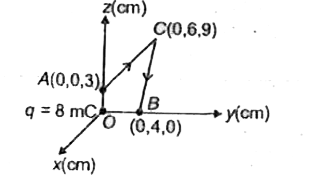Calculate the work done in taking a charge of 0.02 C from A to B, if the potential at A is 20 V, and that at B is 30 V.
To calculate the work done in taking a charge from point A to point B, we can follow these steps:
Step 1: Identify the given values
- Charge (Q) = 0.02 C (coulombs)
- Potential at point A (VA) = 20 V (volts)
- Potential at point B (VB) = 30 V (volts)
Step 2: Calculate the potential difference (ΔV)
The potential difference (ΔV) between points A and B is given by the formula:
ΔV=VB−VA
Substituting the values:
ΔV=30V−20V=10V
Step 3: Use the formula for work done (W)
The work done (W) in moving a charge through a potential difference is given by:
W=Q×ΔV
Substituting the values we have:
W=0.02C×10V
Step 4: Calculate the work done
Now, calculate the work done:
W=0.02C×10V=0.2J
Final Answer
The work done in taking the charge from point A to point B is:
0.2J
---
- Charge (Q) = 0.02 C (coulombs)
- Potential at point A (VA) = 20 V (volts)
- Potential at point B (VB) = 30 V (volts)
The potential difference (ΔV) between points A and B is given by the formula:
ΔV=VB−VA
Substituting the values:
ΔV=30V−20V=10V
The work done (W) in moving a charge through a potential difference is given by:
W=Q×ΔV
Substituting the values we have:
W=0.02C×10V
Now, calculate the work done:
W=0.02C×10V=0.2J
The work done in taking the charge from point A to point B is:
0.2J
Topper's Solved these Questions
- CURRENT ELECTRICITYBook:CENGAGE PHYSICSChapter:CURRENT ELECTRICITYExercise:CHALLENGING EXERCISE
Explore 2 Videos
- CURRENT ELECTRICITYBook:CENGAGE PHYSICSChapter:CURRENT ELECTRICITYExercise:OLYMPIAD AND NTSE LEVEL EXERCISES
Explore 10 Videos
- CURRENT ELECTRICITYBook:CENGAGE PHYSICSChapter:CURRENT ELECTRICITYExercise:MANDATORY EXERCISE(EXERCISE SET V)
Explore 1 Video
- ATOMIC AND NUCLEAR PHYSICS Book:CENGAGE PHYSICSChapter:ATOMIC AND NUCLEAR PHYSICS Exercise:OLYMPIAD AND NTSE LEVEL EXERCISES
Explore 8 Videos
- ELECTROMAGNETIC INDUCTION Book:CENGAGE PHYSICSChapter:ELECTROMAGNETIC INDUCTION Exercise:OLYMPIAD AND NTSE LEVEL EXERCISES
Explore 10 Videos
Similar Questions
Knowledge Check
Calculate the work done in taking a charge −2×10−9C from A to B via C (in diagram )
 A0.2 jouleB1.2 jouleC2.2 jouleDzero
A0.2 jouleB1.2 jouleC2.2 jouleDzeroCalculate the work done for B → A, :-
 A6×10−3jB12×10−3jC3×10−3jD4×10−3j
A6×10−3jB12×10−3jC3×10−3jD4×10−3jThe work done in taking a unit positive charge from P to A is WA and P to B is WB. Then
 .AWA>WBBWA<WBCWA=WBDWA+WB=0
.AWA>WBBWA<WBCWA=WBDWA+WB=0
(a) State the relation between potential difference, work done and charge moved.
(b) Calculate the work done in moving a charge of 4 coulombs from a point at 220 volts to another point at 230 volts.
View SolutionIf 10 J of work is to be done in moving a charge of -200C from A to B, which of the two points is at higher potential ? What is the potential difference ?
View SolutionCalculate the amount of work done to carry 4C of charge from a point at 100V to a point at 120V.
View SolutionFind the work done (in J) when a charge of 20 C moves across a potential difference of 4 V.
View SolutionFind the work done (in J) when a charge of 24 C moves across a potential difference of 6 V.
View Solution